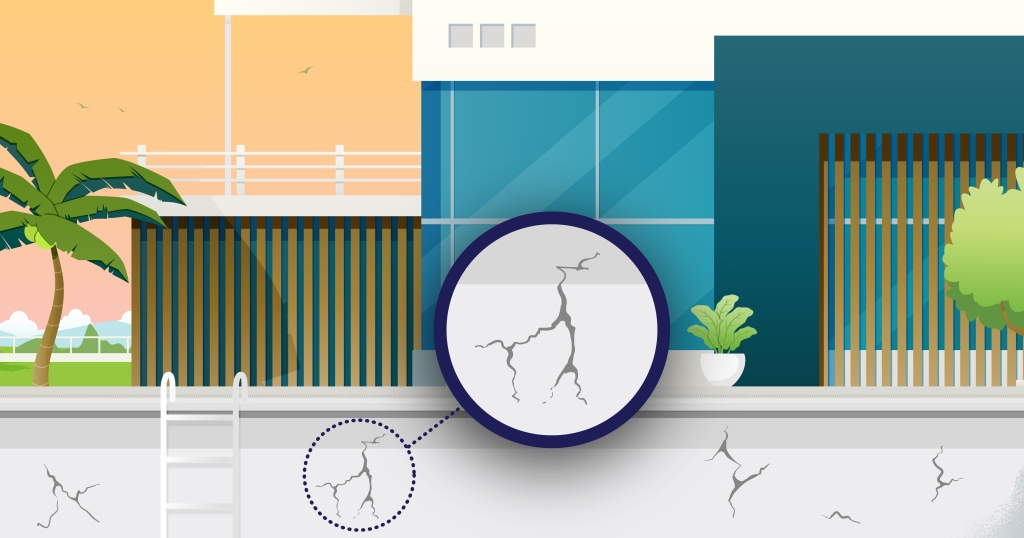Common Pool Plaster Issues
There are many things that need to be done to make sure that your swimming pool stays in the right condition to remain an enjoyable place to spend time in over warmer months.
Some of these tasks – such as keeping the chemicals balanced and ensuring that all equipment is operating effectively – need to be done regularly and can be carried out as part of our weekly pool maintenance service.
One thing that needs far less frequent attention, but which should only become an issue after several years of use, is the condition of your pool plaster. In this article, we’re going to explore some of the problems that can develop with pool plaster, along with why they happen and what you can do to prevent and/or fix them.
But first, let’s start with the basics.
What is pool plaster?
Pool plaster is a layer of cement – usually about a quarter or half-inch thick – that is added to the inside of a pool to provide a waterproof surface that is much smoother than just bare concrete.
Not only that, but your pool plaster can also make the inside of your pool far more attractive, whether by adding a color to the cement mix or having a textured finish such as quartz, pebble, or marbelite.
High-quality plaster that has been installed by professionals should last for eight to ten years. But how do you know when the plaster in your pool is wearing out or is even in need of redoing completely?

Here are five common plaster problems, along with tips on how to keep them at bay.
Top 5 pool plaster issues
-
Scaling
We’ve already mentioned that one of the main purposes of pool plaster is to provide a smooth surface in your pool. We’ve also mentioned that keeping your chemicals balanced is an important job that needs to be done on a weekly basis. One thing that can happen if you don’t keep an eye on the chemicals – particularly if the water becomes too alkaline or there’s too much calcium – is that your surface will become rough with lines, dents, and divots.
How can I prevent or fix it?
Make sure your pool chemicals are regularly checked and brush the walls frequently to remove any buildup that might start to eat into and degrade your pool plaster. However, if the damage gets too severe, you may need to have your pool fully replastered.
-
Spalling
Spalling is when you get flakes of plaster peeling off from the surface of your pool. This is generally the result of plaster that has been poorly applied in the first place, whether by being trowelled unevenly or too thinly.
How can I prevent or fix it?
The only way to prevent spalling from happening is to use a reputable pool builder such as Pulliam Pools. If your pool should suffer from spalling, and the damage isn’t too severe, sandpapering affected areas should deal with it. If that doesn’t do the job, however, a complete replaster – by professionals you can trust – is the only answer.
-
Delamination
Delamination is when the plaster completely separates from the concrete base – and again, this is usually the result of a job that hasn’t been done to the standard required, in this case because the plaster hasn’t been mixed properly.
How can I prevent or fix it?
Again, prevention means using a reliable contractor to do the initial job. If only small areas are affected, it may be possible to patch them, but that may only be a short-term solution. Otherwise, the whole job will need to be done again.
-
Fading
The name pretty much describes the issue here, as over time the color of your plaster will start to fade. This is generally down to exposure to sunlight and the effects of the chlorine that keeps your water clean and safe to swim in.
How can I prevent or fix it?
Covering your pool when not in use should slow down the process. If your surface is white, using a sanitizing solution that contains bleach will help, but it can also wear down the plaster itself over time. If you have a colored surface, you could try using a sanitizing system that uses bromine rather than chlorine, as it won’t impact the color so much.
-
Staining
Staining to the plaster occurs when debris that gets into the pool – especially organic material like leaves and dirt – is left to sink, and attaches itself to the surface. Any metal that gets into the water is likely to rust and also leave marks on the surface.
How can I prevent or fix it?
Regularly brushing and vacuuming your pool should remove much of the debris that can cause these kinds of stains – again, this is included in our weekly maintenance service. If you do get stains, an acid wash should remove them, but bear in mind that this can only be done so many times before it permanently affects the quality of the plaster, so that regular vacuuming and brushing is vital.
If you’re at all worried about the condition of the plaster in your swimming pool, just get in touch with the experts at Pulliam Pools to discuss it and see what can be done. Alternatively, if you want to make sure the potential for any of the above issues developing is kept to a minimum, complete our online weekly maintenance request form, and we’ll get back to you to talk you through your options.
